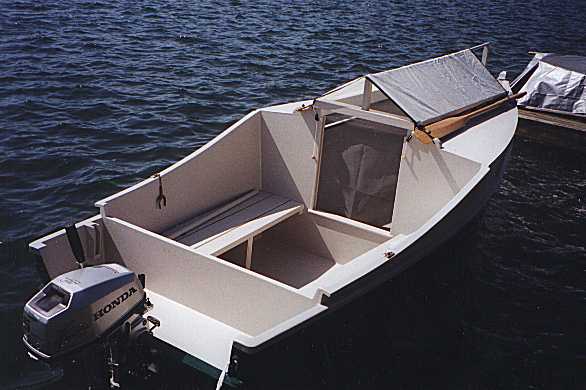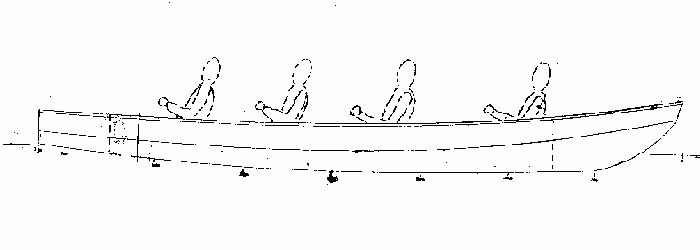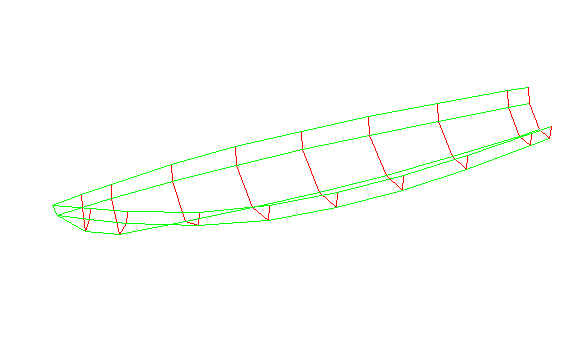
16 year old Daniel Peterson is building this AF4B Down Under. I think his dog is claiming it.
Contents:
Contact info:
Jim Michalak
118 E Randall,
Lebanon, IL 62254Send $1 for info on 20 boats.
Jim Michalak's Boat Designs
118 E Randall, Lebanon, IL 62254
A page of boat designs and essays.
(15feb07) This issue will return to estimating power. The 1 March issue will rerun the lugsail rigging essay.
THE BOOK IS OUT!
BOATBUILDING FOR BEGINNERS (AND BEYOND)
is out now, written by me and edited by Garth Battista of Breakaway Books. You might find it at your bookstore. If not check it out at the....ON LINE CATALOG OF MY PLANS...
...which can now be found at Duckworks Magazine. You order with a shopping cart set up and pay with credit cards or by Paypal. Then Duckworks sends me an email about the order and then I send the plans right from me to you.

|
Left:
16 year old Daniel Peterson is building this AF4B Down Under. I think his dog is claiming it.
|
|
|
Figuring Power 4
ONE MORE TIME WITH AF4B....
I thought I take one more round with the Hullform drag program this time using AF4b. AF4b is just a 15' version of the original 18' AF4. It is just shorter, the width and depth are the same. Here is a photo of the only AF4b I have ever seen, the prototype by Bruce Given:

And another (a beautiful job):

Here is a capture of the Hullform AF4b model:

Here is the Hullform drag prediction for the AF4b at 700 pounds total and trimmed level:

AT THIS STAGE...
...I realized that I could plot curves for various horsepowers on the same graph. Now, recall that a horsepower is defined as 33,000 pounds times feet per minute, a drag times a speed. And this graph has drag on one axis and speed on the other. Now, a knot is one nautical mile per hour or about 6000 feet per hour, or about 100 feet per minute. So a horsepower is about 330 pounds times knots. So if your boat had 330 pounds of drag at 1 knot, it would need one horsepower to push it. In the same way if you boat had 33 pounds of drag at 10 knots it also needs one horsepower to push it. And so forth. I modified the Hullform graph to show where a few different horsepowers would curve across this graph and got this:

I was hoping the horsepower lines would be straight but they aren't. A very important thing to remember here is that, as we discussed in other essays, the horsepower your motor actually propels the boat with is usually only about 1/3 of its rated hp. The rest is "lost" mostly through prop inefficiencies. So the 2hp line here would really be the power delivered by a motor rated at 6hp, the 4 is a 12hp and the 6 is an 18hp motor.
With that in mind we can look at the new curves and guess that the AF4b in this weight and cg condition would have a top speed of about 8knots with 6hp, about 14 knots with 12hp and 18 knots with 18hp. Another way to look at it might be to say with an 18 hp motor top speed will be about 18 knots and if you throttle back to 66% power you might cruise at 14 knots. Or if you have a 12 horse motor top speed will be about 14 knots and cruise at about 10 knots.
I am getting a lot of faith in this program. Those numbers are what I see with my AF4 although my boat is a bit longer and heavier. So the key word here is probably "about".
LET'S LOOK AT THE EFFECT OF WEIGHT...
It is easy to run Hullform with a range of weights. Here I used a range from 500 pounds to 1000 pounds. (I doubt if anyone will be actually running down at 500 pounds.) The example had a cg location at 10' aft of the bow which is where it trims static level according to Hullform.

If you look at the 4hp line you see the 700# AF4b will run at about 14knots while the 1000# boat will be at 10 knots and that is a big difference. The 2hp line indicates that the 700# boat is barely on plane at just over 8 knots but the heavy boat is still displacement at about 6 knots. It appears that the 1000# boat will need 4hp to plane at all and there is a "hump" in the curve that it must get over. You might recall that my thrustometer tests with AF4 showed no hump but I was testing at about 800 pounds or so. I suspect the "hump" showed on the low speed red line doesn't really exist for AF4 anyway. At least I never found it in the tests.
LET'S LOOK AT THE EFFECT OF CG LOCATION...
I stuck with the 700# weight and let the cg location vary from 8' to 12' as measured from the tip of the bow. I don't recall doing cg calculations for this boat but I suppose the 8' location might agree with boating with a passenger in the cabin slot, and the 12' cg might agree with everything and everybody all the way to the stern. Anyway, here it is:

Well, you can see this predicts that at low speeds the forward cg has by far the lowest drag and at high speeds the aft cg has the lowest. And you can see that the aft cg location goes off scale on the drag at low speeds. It has a huge "hump" and it appears that the 6hp (about 18 hp rated) won't get it past that hump. Perhaps a quick burst of power will pop it past.
Another interesting thing here is that all the lines sort of cross at about 14 knots. I think most AF4 boaters have noted that life is sweet at 12 to 14knots and maybe this is why - speed is not sensitive here to trim. With 4hp pushing we see the fwd cg boat is going about 13 knots and the aft cg boat about 14, almost no difference and yet the cg difference is huge.
With 2hp pushing we see the fwd cg boat is actually on plane, going about 10 knots!
WELL...
... all of this is in line with my AF4 experiences and I see no need to doubt the Hullform predictions and I see no need to guess at speeds anymore. If you have built a Hullform model for your boat then you might as well trust it. Keep in mind to use about 1/3 of the rated hp and you should get good answers.
NEXT TIME...
We take another look at rigging a lug sail.
Raider
RAIDER,ROW/ SAIL RACEBOAT, 7.3M X 1.3M, 200 KG EMPTY

Raider was designed to meet the needs of a RAID race in the Baltic where boats are raced by sail and oars but the crews sleep and eat ashore. So no real storage is required. Norm told me to allow for 700 pounds of crew (4 oarsmen) and to make certain the boat could be switched from oars to sail very quickly, even use both oars and sail at one time. Norm had become very used to my usual lugsail/leeboard rig that he had on his Normsboat and wanted to rig the boat that way. We sat at McDonald's with pencil and paper and coffee and sketched this;

At that point we were thinking to stagger the oarsmen who would use a single long oar each but later I thought to put them in a row so that they could use oars in pairs thus making crewing simpler. Like this;

I gave each man a meter of length to work in. The bow man looks to have a bit more but he doesn't. I planned a boxed bulkhead at his feet on which to hang the sail rig which would separate him from the rest of the crew - a good place to punish someone. So the sail rig started to look like this:

Did I say these plans had to be in metric since the boat was to be built in Europe? So my first ever set of metric plans. Keep an eye out for errors! (I still stick with English units with most designs since materials and tools here are in English.)
Anyway, I used a Normsboat lug sail, 115 sq ft., since Norm already had one and it looked OK. It is probably too large but with a big crew to handle, it might be fine and should give some thrills. The RAID race has rescue boats close at hand. There was an issue with the leeboards. The sides of this boat need to be low to give the oars good rowing geometry. That meant any sort of folding water board would also have to be narrow. To get the proper board area the board needed to be quite long and narrow and there really should be two! One on each side, something I never had to do before. There is a chance that one will be sufficient, especially if the situation of crashing slowly to windward in rough water is avoided since that is where board area becomes critical.

The hull itself is long and narrow and a pretty deep V and I should think will be very fast under oars including in rough water. It will be tippy but four crewmen hanging to windward should make a fast sailing canoe out of it. It will be "brisk", yes?

Construction is to be of taped seam plywood, and I was thinking all of 9mm ply (3/8"). I did not do a plywood sheet count not really knowing what size panels are available in Europe. But all the panels and pieces are dimensioned for assembly in the "instant" method.
The untested prototype Raider plans are $30.
Prototype News
Some of you may know that in addition to the one buck catalog which now contains 20 "done" boats, I offer another catalog of 20 unbuilt prototypes. The buck catalog has on its last page a list and brief description of the boats currently in the Catalog of Prototypes. That catalog also contains some articles that I wrote for Messing About In Boats and Boatbuilder magazines. The Catalog of Prototypes costs $3. The both together amount to 50 pages for $4, an offer you may have seen in Woodenboat ads. Payment must be in US funds. The banks here won't accept anything else. (I've got a little stash of foreign currency that I can admire but not spend.) I'm way too small for credit cards.
I think David Hahn's Out West Picara is the winner of the Picara race. Shown here on its first sail except there was no wind. Hopefully more later. (Not sure if a polytarp sail is suitable for a boat this heavy.

Here is a Musicbox2 I heard about through the grapevine.

We have a Philsboat going together in California. You can see the interior room in this 15' boat:

And here is another Philsboat in northern Illinois:

HOLY COW! A Jukebox2 takes shape in Minnesota. Unheated shop means no work during the winter. Check out that building rig!

And the Vole in New York. Going very quickly but most likely there will be little more done during the cold winter.

AN INDEX OF PAST ISSUES
Hullforms Download (archived copy)
Plyboats Demo Download (archived copy)
Brokeboats (archived copy)
Brian builds Roar2 (archived copy)
Herb builds AF3 (archived copy)
Herb builds RB42 (archived copy)